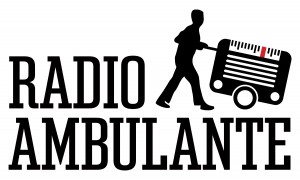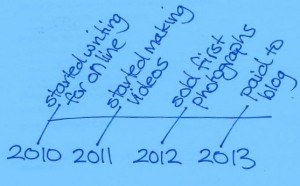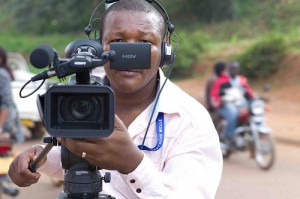Search Results for Tag: storytelling
Radio Ambulante – a new kind of radio for the Spanish-speaking world
 Bringing powerful audio stories to Spanish speakers across the Americas, that’s the goal of Radio Ambulante. The California-based show is a home for long-form, sound-rich radio features driven by strong characters and compelling voices – a format that is not very common in the Spanish-speaking world.
Bringing powerful audio stories to Spanish speakers across the Americas, that’s the goal of Radio Ambulante. The California-based show is a home for long-form, sound-rich radio features driven by strong characters and compelling voices – a format that is not very common in the Spanish-speaking world.
The show was inspired by a reporting trip novelist Daniel Alarcón made to his native Peru on assignment for the BBC. While investigating migration there, Alarcón travelled across the country recording personal stories from a wide range of people. But when he later heard the final mix, he was disappointed that the producers had largely highlighted the English speakers he talked to, leaving out much of the compelling material in Spanish. He wondered what the result would be if there was a place where Spanish-language voices could be heard.
In 2012, with the help of a successful Kickstarter campaign, Radio Ambulante was born. Programs have featured a transgender Nicaraguan woman living with her wife in San Francisco, a Peruvian stowaway describing his frightening journey to New York, and an Argentine who was jailed during that country’s dictatorship and given the choice to either work or to die. “Ambulante” can mean traveling or itinerant but also refers to “ambulantes”: street vendors who sell all kinds of wares in many Latin American cities.
While Radio Ambulante has a growing list of terrestrial stations that carry it, the show is largely distributed digitally. In early October, Radio Ambulante was awarded the Gabriel García Márquez Journalism Award in the innovation category. onMedia put a few questions to Radio Ambulante’s co-founder and executive director, Carolina Guerrero, about how the show’s format has been received in Latin America and where the show wants to go to from here.
![]() read more
read more
Tools & Apps for Journalists: Meograph
What is Meograph?
 Meograph is a web-based multimedia tool that makes it simple to put together different elements such as video, photos, audio, narration, music, text and links to tell a story. What is especially nice about this tool is the ability to plot the changing location of events on Google maps and to also pin events to a timeline. The final product has similar dimensions to a YouTube video and also comes with a play, pause and stop button. Meograph embeds easily in websites or social media making it easy to share.
Meograph is a web-based multimedia tool that makes it simple to put together different elements such as video, photos, audio, narration, music, text and links to tell a story. What is especially nice about this tool is the ability to plot the changing location of events on Google maps and to also pin events to a timeline. The final product has similar dimensions to a YouTube video and also comes with a play, pause and stop button. Meograph embeds easily in websites or social media making it easy to share.
![]() read more
read more
Tools and Apps for Journalists: TimelineJS
 Timelines arrange events in chronological order. From learning about dinosaurs or the order of kings and queens at school, at some stage you would have stumbled over a timeline. The point of a timeline is to make it easier to understand when things happened.
Timelines arrange events in chronological order. From learning about dinosaurs or the order of kings and queens at school, at some stage you would have stumbled over a timeline. The point of a timeline is to make it easier to understand when things happened.
There are plenty of Internet tools to help you create a timeline, but one tool that is popular with media organizations is TimelineJS.
What is TimelineJS?
 TimelineJS (Java Script) lets you easily link to different multimedia sources. So as well as text, you can include videos from YouTube and Vimeo, audio from SoundCloud, photos from Flickr, Tweets, Googlemaps and Wikipedia entries and more. Scribd is also useful for including text documents.
TimelineJS (Java Script) lets you easily link to different multimedia sources. So as well as text, you can include videos from YouTube and Vimeo, audio from SoundCloud, photos from Flickr, Tweets, Googlemaps and Wikipedia entries and more. Scribd is also useful for including text documents.
Other media are regularly added so check with the TimelineJS website to see what else they support.
As a result, TimelineJS makes it easy to visually show events and the interactivity means users can explore further if they want to.
![]() read more
read more
Tools and Apps for Journalists: Cowbird
What is Cowbird?
A multimedia storytelling tool. But Cowbird strips things back to present stories in a straightforward way. Think simple: text, photographs, and audio. The story is the focus – as it should be.
![]() read more
read more
Painting a different picture of Africa
Being part of the African Stories workshop in Cape Town, I was most excited about meeting fellow young journalists from all over Southern Africa. The first thing I noticed was that we have a lot in common. They, as journalists, want their voices to be heard and they are eager to tell their own stories. But even more so, they want to show the world who they are as Africans – and not leave that to media outlets outside of Africa, which in their view, often present a one-sided image of the continent.
“Western journalists often only concentrate on one area like poverty,” said Mathews Nthala, editor at MUVI TV in Zambia. “In this workshop, we are given the opportunity to show that there is a lot of potential in Africa. Many people are doing well in terms of entrepreneurship and self-empowerment. An African led empowerment, that to me sums up what African Stories is about.”
![]() read more
read more
Producing compelling African stories
Turn around and you will find a story to tell. That’s what DW-Akademie’s new journalism training project African Stories is all about: African journalists telling African stories and taking a closer look at their society.
 In short, the project aims to train journalists to produce interesting and professionally produced TV reports and documentaries – offering their audience an African perspective on a number of issues ranging from environmental protection, economic development and governance to poverty reduction, health and education.
In short, the project aims to train journalists to produce interesting and professionally produced TV reports and documentaries – offering their audience an African perspective on a number of issues ranging from environmental protection, economic development and governance to poverty reduction, health and education.
African Stories is also ambitious in scale involving broadcasters from across the continent. Television stations participating in the project send a production team to attend a two-week training course. The reports produced by each team during the training are in turn made available to all of the participating broadcasters.
To give you a better idea of the project, here are some stories produced during the recent workshop in Kampala in June.
![]() read more
read more






Feedback